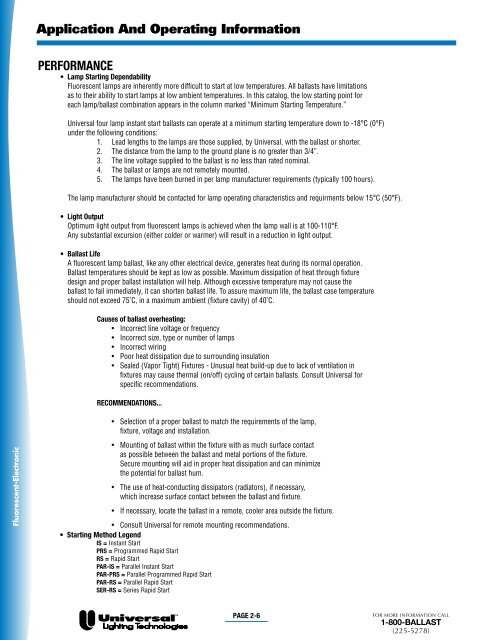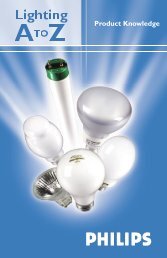triad® electronic ballasts - Conserve-A-Watt Lighting, Inc
triad® electronic ballasts - Conserve-A-Watt Lighting, Inc
triad® electronic ballasts - Conserve-A-Watt Lighting, Inc
Create successful ePaper yourself
Turn your PDF publications into a flip-book with our unique Google optimized e-Paper software.
Application And Operating InformationPERFORMANCE• Lamp Starting DependabilityFluorescent lamps are inherently more difficult to start at low temperatures. All <strong>ballasts</strong> have limitationsas to their ability to start lamps at low ambient temperatures. In this catalog, the low starting point foreach lamp/ballast combination appears in the column marked “Minimum Starting Temperature.”Universal four lamp instant start <strong>ballasts</strong> can operate at a minimum starting temperature down to -18°C (0°F)under the following conditions:1. Lead lengths to the lamps are those supplied, by Universal, with the ballast or shorter.2. The distance from the lamp to the ground plane is no greater than 3/4”.3. The line voltage supplied to the ballast is no less than rated nominal.4. The ballast or lamps are not remotely mounted.5. The lamps have been burned in per lamp manufacturer requirements (typically 100 hours).The lamp manufacturer should be contacted for lamp operating characteristics and requirments below 15°C (50°F).• Light OutputOptimum light output from fluorescent lamps is achieved when the lamp wall is at 100-110°F.Any substantial excursion (either colder or warmer) will result in a reduction in light output.• Ballast LifeA fluorescent lamp ballast, like any other electrical device, generates heat during its normal operation.Ballast temperatures should be kept as low as possible. Maximum dissipation of heat through fixturedesign and proper ballast installation will help. Although excessive temperature may not cause theballast to fail immediately, it can shorten ballast life. To assure maximum life, the ballast case temperatureshould not exceed 75˚C, in a maximum ambient (fixture cavity) of 40˚C.Causes of ballast overheating:• <strong>Inc</strong>orrect line voltage or frequency• <strong>Inc</strong>orrect size, type or number of lamps• <strong>Inc</strong>orrect wiring• Poor heat dissipation due to surrounding insulation• Sealed (Vapor Tight) Fixtures - Unusual heat build-up due to lack of ventilation infixtures may cause thermal (on/off) cycling of certain <strong>ballasts</strong>. Consult Universal forspecific recommendations.RECOMMENDATIONS...Fluorescent-Electronic• Selection of a proper ballast to match the requirements of the lamp,fixture, voltage and installation.• Mounting of ballast within the fixture with as much surface contactas possible between the ballast and metal portions of the fixture.Secure mounting will aid in proper heat dissipation and can minimizethe potential for ballast hum.• The use of heat-conducting dissipators (radiators), if necessary,which increase surface contact between the ballast and fixture.• If necessary, locate the ballast in a remote, cooler area outside the fixture.• Consult Universal for remote mounting recommendations.• Starting Method LegendIS = Instant StartPRS = Programmed Rapid StartRS = Rapid StartPAR-IS = Parallel Instant StartPAR-PRS = Parallel Programmed Rapid StartPAR-RS = Parallel Rapid StartSER-RS = Series Rapid StartPAGE 2-6FOR MORE INFORMATION CALL1-800-BALLAST(225-5278)




